1968 Monaco Grand Prix race report: Lotus gives Hill wings
Graham Hill takes his fourth victory on the prinicipality streets; Servoz-Gavin impresses by leading early on but retires
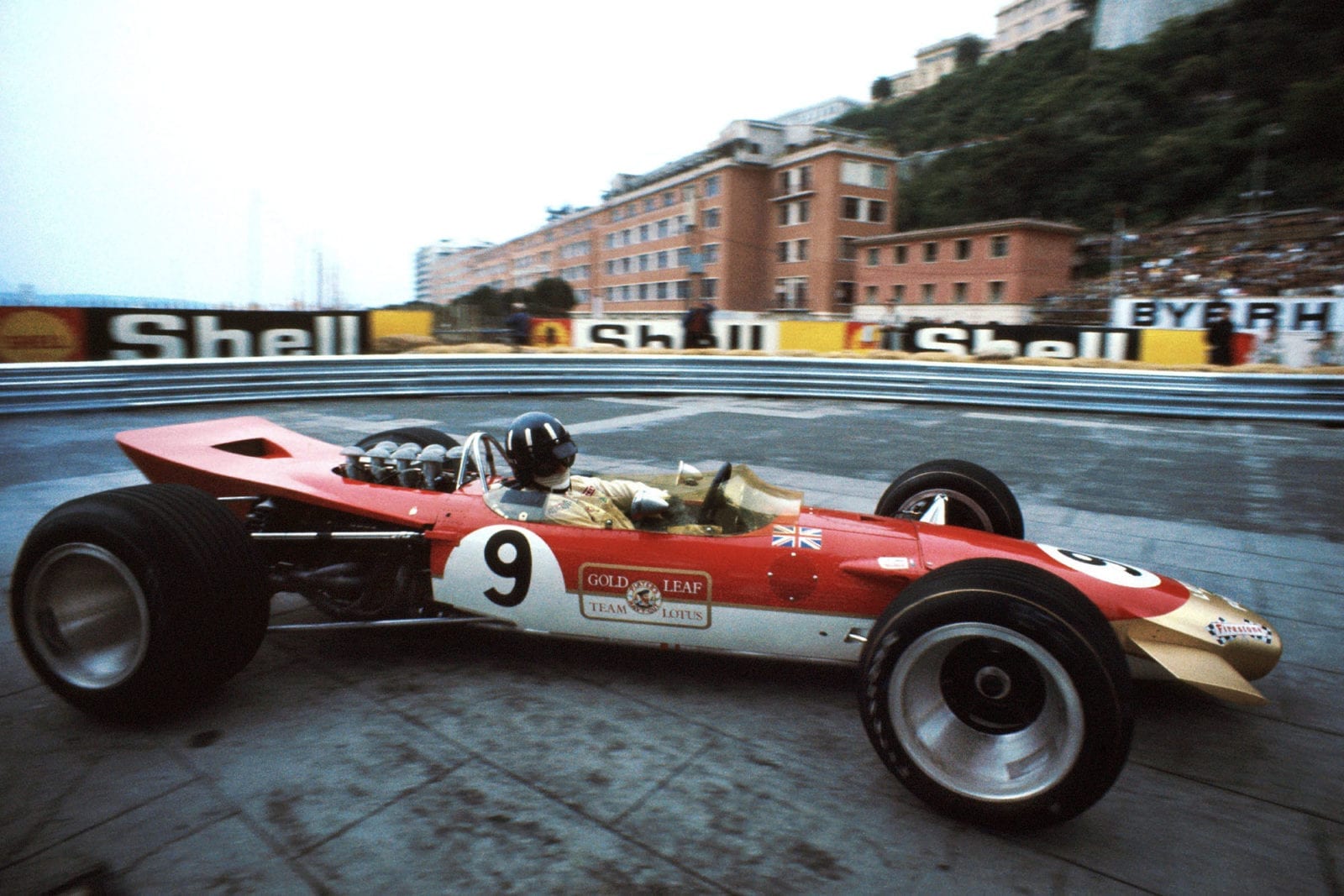
Graham Hill took his fourth win on the streets on Monaco
Motorsport Images
Quite often people ask the question “What is a classic motor race?” and one simple answer is “The Grand Prix race round the streets of Monte Carlo”. Even though the starting grid is limited to sixteen cars and this year there were only two serious competitors running just after half distance, the twenty-sixth Monaco Grand Prix was as classic as all its forebears, for the happenings during the four days of the meeting were full and varied and provided the true appeal of Grand Prix racing, which was never meant to be an easy and simple activity for anyone who thinks he is a racing driver.
The Monte Carlo circuit is ridiculously short, only 3.145 kilometres (approx 1.9 miles) to the lap, absurdly slow, 128.513kph (approx 79.8mph) record lap, it has three bottom gear hairpins, nowhere can you reach more than about 120mph and then only for a second or two, and if the circuit were in England it would be described as a “Mickey Mouse” track suitable for kiddy-cars.
The fact that it is not a “track” as we know the word, but a circuit laid out on the normal streets of the town of Monte Carlo, running steeply uphill between hotels and gardens, plunging equally steeply downhill, running through a tunnel built on a right hand curve, dodging through an artificial chicane on to the harbour promenade, along a length of promenade that is normally a footpath and forbidden to motor traffic and the whole affair is overlooked by the towering buildings of Monte Carlo with high mountains forming a back-cloth makes it all that much different from a slow wiggly “track” laid out in a field.
By any reasoning the Monaco Grand Prix is a classic, even if the organisation is a bit old-fashioned and lacking by some people’s standards, and it is the ultimate in “street-racing” and almost the last stronghold of this exacting form of motor racing. At one time there were many town circuits like Monte Carlo, and the Grand Prix driver had to learn the art of driving fast within very exacting limits, mere inches making the difference between smooth cornering and buckling a wheel rim on a kerbstone.
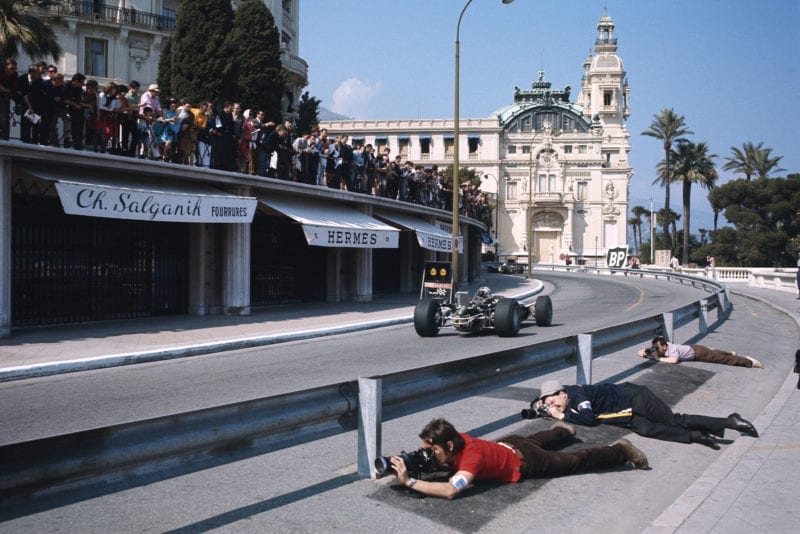
Photographers do their utmost to get a good shot at Massenet
Motorsport Images
The sloppy airfield-trained driver, who could be three feet off line and still get through a corner was unknown in the heyday of town racing. Monte Carlo still calls for precise and accurate driving judgement and sharp reflexes, coupled with a certain bravado, quite different from the cool judgement and skill needed at Spa when taking a 180mph corner on full-throttle.
The Monte Carlo circuit has changed little since its inception in 1929, but whereas a slight error of judgement meant that you put a front wheel up the kerb and across the footpath, with the risk of a burst tyre or bent wheel, today a similar error will almost certainly mean a bent and buckled suspension and the end of your race, for not only are the cars not built for such impact loads, but most of the circuit is lined by steel barriers (American influence!) which cause enormous damage to any car that hits them.
There is far less margin for driver error today at Monte Carlo, and with the 400bhp Grand Prix cars competing now, the driver has a much more exacting task. The so-called “safety-barriers” of steel that are growing up on all circuits like “triffids” may protect the walls of the town of Monte Carlo but they do enormous damage to the competing cars if the driver makes a small error.
“It seems the reduction in race length was connected to the fact that Bandini crashed on lap 82 and that by lap 80 he had shown signs of fatigue”
Since the unfortunate accident to Bandini last year the AC of Monaco made two feeble moves; they repositioned the chicane on to the harbour, further along from the tunnel and made it more acute, and they reduced the race distance from the classic 100 laps to 80 laps.
The reduction in race length was attributed to some vague talk about bringing the race in line with other Grand Prix events as regards time duration, but it seems that it was connected to the fact that Bandini crashed on lap 82 and that by lap 80 he had shown signs of fatigue and the club did not want to risk a repetition of that unhappy incident.
Another notable change in the 1968 race was the complete abstention by the Ferrari team, no reason being given by Enzo Ferrari and none really being needed, for nobody is forced to accept an invitation to participate in a race. There were ten invited entries, given to manufacturers’ teams and suitable drivers, and these were Matra with Beltoise, Brabham with himself and Rindt, BRM with Rodriguez, Cooper with Scarfiotti, Honda with Surtees, Lotus with Graham Hill, McLaren with himself and Hulme, and AAR-Eagle with Gurney.
The remaining six places on the grid had to be decided by fastest practice times between the rest of the drivers whether they were in factory cars or private ones. With Irwin still in hospital after his crash at Nurburgring, his place in the BRM team was taken by Attwood, who was already entered by Tim Parnell; with Redman honouring his Gulf contract to drive a GT40 Ford at Spa his place in the Cooper team was taken by Lucien Bianchi.
The second Gold Leaf Team Lotus entry was entrusted to Jack Oliver, while the Tyrrell Matra-International entry was given to Johnny Servoz-Gavin as Stewart still had his wrist in plaster, Beltoise had the works Matra entry and Pescarolo was at Spa with the new Matra V12 Group 6 Prototype.
Courage was driving for Tim Parnell, Siffert for Rob Walker, Moser for Charles Vogele and Bonnier was driving for himself. These eight had to keep a wary eye on one another throughout practice, for the slowest two would be non-starters, even if they were faster than the invited drivers and cars.
Qualifying
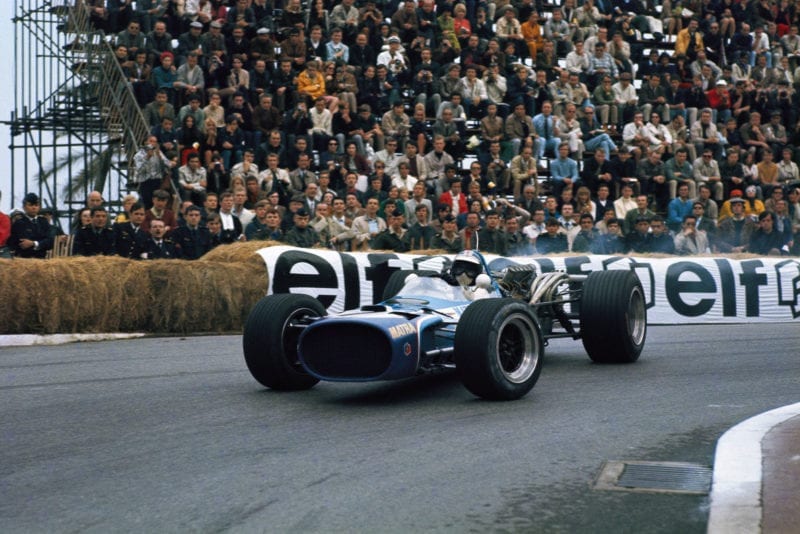
Beltoise negotiates a bout of understeer for the new Matra team
Motorsport Images
Practice began on Thursday afternoon in spite of France being in the throes of a general workers’ strike and political unrest, and it was generally agreed that the repositioned chicane would slow lap times by about one second compared with last year.
What was not agreed was what last year’s standards were, for though the official programme told you that the race lap record stood to Jim Clark at 1min 29.5sec it gave no information on practice times, and, in passing, it omitted the recent Spanish Grand Prix from the 1968 list of World Championship events!
Someone started the erroneous information that in 1967 Clark had made the fastest practice lap in 1min 28.5sec and few people were prepared to doubt this, such is the esteem with which Clark’s memory lives on. It was quite false, for in 1967 he was still awaiting the 400bhp Cosworth V8 engine and was using a low-powered Coventry-Climax 2-litre V8 and his best practice time was 1min 28.8sec, this time being equalled by Hulme and beaten by Surtees, Bandini and Brabham.
Right at the end of the 1967 practice Brabham had made fastest time in 1min 27.6sec, but as things turned out it was probably just as well that most people seemed not to know this! Matra were out, in force, well on time and ready to run, a very impressive effort, remembering that it is only just over four months since their Grand Prix engine first fired on the test-bed.
They had two of their V12-engined cars, the original test car that has done all the test running at Montlhéry and Le Mans, and a brand new one, both being designated MS11 models. Alongside them were Tyrrell’s two MS10 cars, both with V8 Cosworth engines, and remembering that Pescarolo was at Spa with the new V12 Matra Prototype sports car, it can be appreciated that Matra are forging ahead.
Lotus had two cars, the remodelled 49/5 that went to Spain but did not run, now being driven by Hill, and 49/1 that was victorious in Spain now being driven by Oliver. The first of the 1968 works Coopers was driven by Bianchi and the second one by Scarfiotti, both being as raced in Spain. McLaren and Hulme had the cars they drove in Spain, McLaren’s own car still having the slight “crinkle” in the monocoque structure that it received in its practice crash at Jarama, as it had not upset the alignment.
Having crashed the first of the BRM P133 cars in Spain, Rodriguez was driving the second one and Attwood was driving the third of the P126 BRM cars, Courage driving the first of the P126 series. The only real difference in these two models is that the P126 series were built by Len Terry, away from Bourne and the P133 models were built at Bourne by BRM themselves, to the original Terry design.
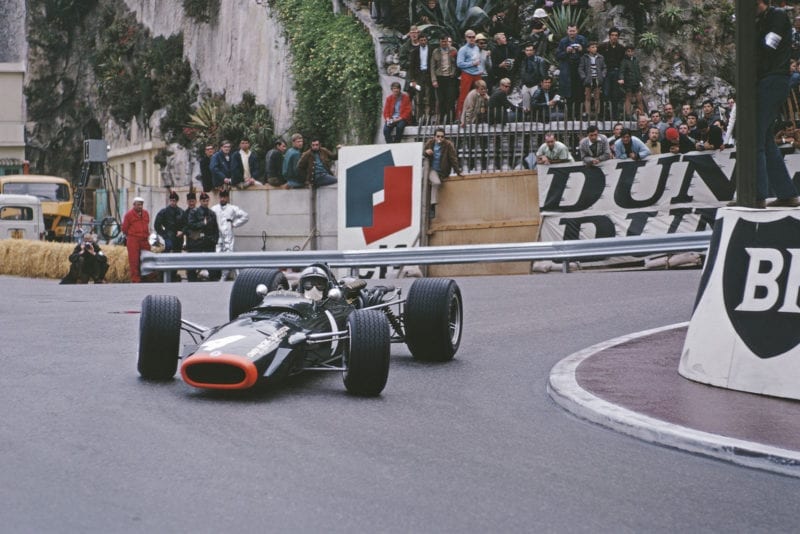
Rodriguez takes the station hairpin in his BRM
Motorsport Images
Surtees had the 1968 Honda, Rindt the 1967/68 Brabham he had driven briefly in Spain, and Brabham his new car with the 4-cam Repco engine rebuilt after its disastrous first appearance.
However, although the car was at first practice it was not ready to run and was awaiting the owner to arrive with parts for the injection system. Walker’s Lotus 49 had arrived in a nice new Ford van, but was not ready for Siffert to drive when practice began at 2pm.
Gurney’s lone Eagle was the last of his 1967 Formula One cars, but had the first of Eagle’s own V12 engines installed, the cam-box covers no longer saying “Gurney-Weslake”, but “Eagle-Mark 1A”, though it is the same design of Weslake V12 engine. Bonnier had his McLaren M5A with V12 BRM engine, and Moser the Brabham-Repco V8 that Ligier drove last year.
In this first practice three young drivers were having new experiences with 400bhp; Beltoise was making his first public appearance with the 12-cylinder Matra, Oliver was having his baptism in a 400bhp. Lotus and Servos-Gavin was having his first drive in a Grand Prix car. The Cosworth V8 in the capable hands of Hill, McLaren, Hulme and Siffert was having its introduction to “street-racing” and the 12-cylinder BRM engine in various cars and with various drivers was making itself heard at Monaco for the first time.
As practice got under way it was difficult to know which way to look or which way to listen, with the fantastic sound of the V12 Matra engine, the V12 Honda and the V12 Eagle. The slightly less raucous noise of the V12 BRM engines, the efficient sound of the Cosworth V8 engines, and all that was missing was the sound of the 4-cam Repco V8 from its two megaphone exhausts. All this echoing off the rock faces and hotel fronts made the most incredible noise that seemed to lift you off the ground with excitement.
Quite soon most drivers were accelerating, sliding, braking and cornering with enormous vigour and the invited ones were out for a high place on the starting grid and the uninvited ones were out to make sure they were not the slowest or next to slowest. Servoz-Gavin and Beltoise were a joy to watch, their uninhibited handling of new cars with lots of horsepower being refreshing.
“Servoz-Gavin was not afraid to give it full-throttle out of corners and travel a long way in an “opposite-lock” power slide”
The 12-cylinder Matra engine seemed to require keeping well up near its 10,000rpm limit, which kept Beltoise busy, but he looked to be enjoying himself. Servos-Gavin was obviously happy to have such a responsive and powerful car as the Matra-Cosworth V8 and was really using its potential, not being afraid to give it full-throttle out of corners and travel a long way in an “opposite-lock” power slide.
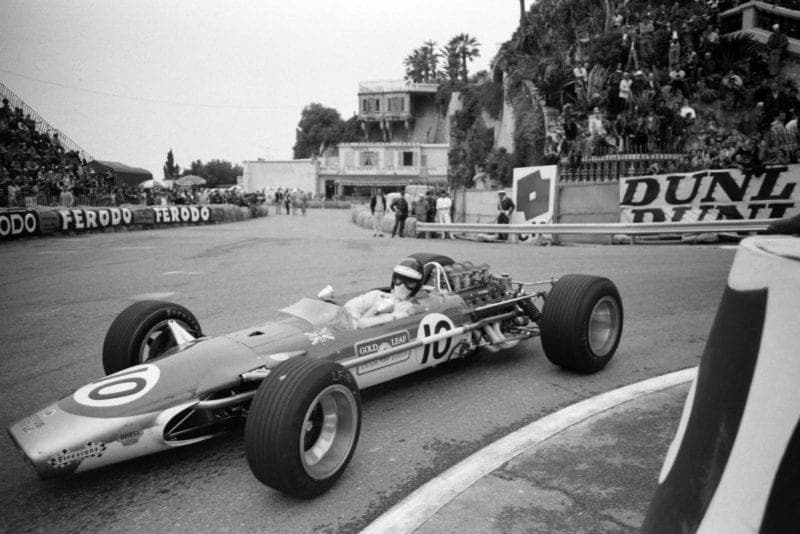
Jackie Oliver showed well in his first appearance for Lotus
Motorsport Images
Oliver was also showing up well on his first outing with a real Grand Prix car, but he was less spirited than the two French lads. The McLarens were riding the humps on the concrete of the promenade in a very impressive manner, but Rindt’s Brabham-Repco V8 looked terrible, its front suspension too hard, though the driver seemed oblivious to it.
The great rush with which practice began died away after a time, partly as initial enthusiasm wore off, but mainly because of numerous mechanical disasters, some caused by hasty preparation, some by inadequate pre-race testing, and some by new conditions arising at Monte Carlo. With rear tyres getting wider and smaller in diameter and providing more grip the transmission of the Grand Prix car undergoes enormous strains, especially now that many engines are developing 400bhp and more.
A lap of Monte Carlo imposes four virtual standing-starts, three out of the hairpins and one away from the slow right-hand bend where the Circuit joins the sea-front road. On every lap, if the driver is brave and really uses the acceleration available, the cars do “drag-race” starts four times in around 1½ minutes, so it was no surprise that weaknesses in crown-wheels and pinions, gearbox casings, drive-shafts, hubs, universal joints and so on, began to show up.
Siffert’s Lotus 49 broke the outer universal joint on the left-hand drive shaft, as well as the crown-wheel and pinion, the Honda stripped teeth off its crown-wheel, and Scarfiotti’s Cooper sheared the bolts in a drive-shaft universal joint.
The brand new Eagle V12 engine hardly got going before it blew up and the car was left derelict by the edge of the road, and the Matra V12 test-car developed an enormous oil leak at the front of the engine, so Beltoise did most of his practice in the new car, a lot of it without the nose cowling on as it was running a bit hot.
The McLarens and Coopers had special short nose cowlings with larger apertures than normal. The new Lotus was going well and Hill was taking on the role of team leader with great effect, setting the pace with steady, fast driving that looked effortless. The only real trouble the car was having was with the oil system, for the tank was too small and was frothing the oil and blowing it into the catch-tank, which was filling up and over-flowing after a few laps.
Hill was the only driver to get near to the existing lap record, with 1min 28.9sec and Rindt was the only other driver to break a 1min 30sec, but whereas Hill looked as though he could do his time all day long, Rindt looked like an impending accident.

Servoz-Gavin immediately showed the potential of the new Matra design
Motorsport Images
Servos-Gavin made the excellent time of 1min 31.1sec with the newer and lighter Matra-Cosworth V8 on his first outing in a Grand Prix car, and Siffert was obviously going to show that he was mastering the Lotus 49 by turning in a lap at 1min 30.8sec.
Quietly and efficiently Attwood had recorded 1min 30.5sec but the rest were not unduly impressive, Hulme and Gurney seemingly having their thoughts on Indianapolis, the former due to fly to America to qualify and the latter having everything at stake on the outcome of the 500-mile race.
On Friday, practice was at 8am and conditions were still warm and dry, the previous day’s mechanical disasters were mostly repaired, except that Gurney was still trying to get another engine from England, but Brabham had arrived with the parts for his 4-cam Repco V8 engine. There was a general improvement all round, as far as lap times were concerned, but trouble was still rife and breakages frequent, while at one point everyone seemed to be losing oil.
Scarfiotti was very uncomfortable with feet soaked in hot oil from a leak, Oliver walked back to the pits with a piece of broken drive-shaft universal joint in his hand, McLaren had a pin shear in an inboard universal joint, the Honda had the left rear wheel attachment start to break up and Siffert had another crown-wheel and pinion break in the ZF gearbox.
It was found that Oliver’s car had the same trouble and it looked as though the ZF casings were expanding under power, as they had done on the Bugatti circuit last year, so for final practice the heavy cast-iron side plates were fitted. The new works Lotus with its Hewland gearbox was having no transmission trouble, but was still filling its oil catch-tank, so it had another container fitted to catch the overflow tank’s overflow!
Before running into trouble Siffert had beaten Hill’s best time of the day before, which impressed everyone, but Servos-Gavin had already done this in the newer of the two Matra-Cosworth V8 cars. A lap time of 1min 30sec seemed to be bogey time and many seasoned drivers could not get under this, so it was all the more creditable when “new boy’s” managed to get below this figure.
Beltoise had only the new car to practise with, the “hack” car still being repaired, and he got down to 1min 29.7sec. Siffert and Servos-Gavin had done 1min 28.8sec, Rindt 1min 29.2sec, and Attwood 1min 29.6sec, but Surtees upheld the “old brigade” with 1min 29.1sec.
Once again it was left to Hill to preserve the standards and just before practice ended he went round in 1min 28.2sec, inside the existing lap record, but a long way off Brabham’s 1967 practice time. During this lap Hill clipped a kerb with his left rear wheel and took a large piece out of the magnesium wheel rim, making it so much scrap metal, so that it was an expensive fastest lap for Team Lotus.
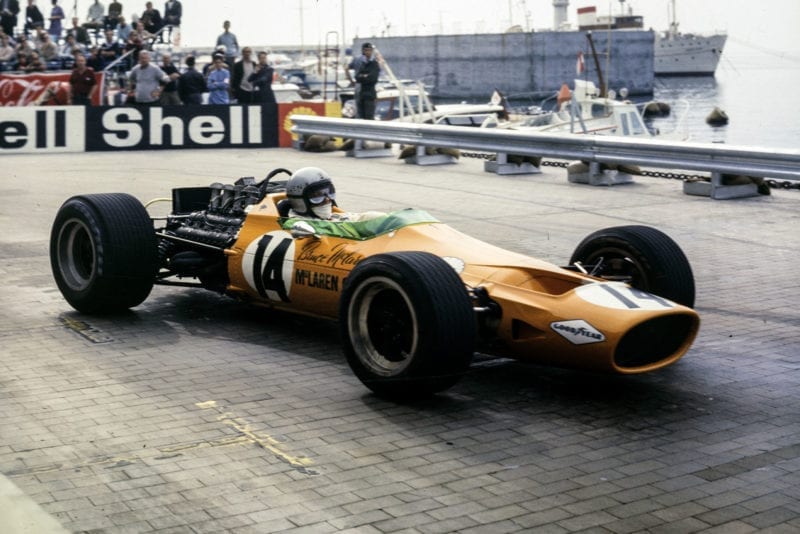
McLaren threads through the chicane
Motorsport Images
The final practice was on Saturday afternoon, following two Formula Three race heats, and the weather was wet and drizzly most of the time so that there was little hope of much excitement. Gurney had got a new engine in the Eagle, the “hack” Matra V12 was running again, the ravages of the previous practice were repaired and Hulme was in America qualifying for the Indianapolis race, having left while the Friday practice was still in progress.
McLaren was trying out some new cup-inserts in his drive-shafts, but the hardening process was wrong and they broke up depressingly quickly so a lot of time was spent replacing the shafts. He did a few laps in Hulme’s car, which the organisation credited to Hulme, even though he was in America! The V12 Matra was using some Dunlop tyres with the centre block of the tread removed, which made the wide tyre look like two narrow tyres, in the manner of twin rear tyres that used to be run in hill-climbs.
The new Eagle engine was running very badly and a lot of time was spent in the pits by Gurney, but with the wet circuit this did not matter too much. The tail-enders were watching lap times carefully, and when Bianchi began to go better in the Cooper, Bonnier and Moser had to make a serious effort to stay in the select sixteen, but as the practice period went on the weather improved and the roads became almost completely dry.
Bianchi got down to 1min 31.9sec so this meant that Bonnier and Moser were out, unless they could improve on this, but they both failed. Servos-Gavin had made his previous best time with 11T on the lighter MS10 Matra, the T being for training, and a lot of people thought this should not count for the grid, so in this final practice the car was numbered 11, and he waited for the circuit to dry to try and repeat his 1min 28.8sec under his proper racing number and prevent any arguments.
Actually it was sour-grapes, for he was on the front row of the grid alongside Hill, and this was his first 3-litre Grand Prix car drive. He was foiled in his attempt as practice closed, for the newer car developed a grabbing front brake and there was no time to investigate the trouble. Rindt was still below bogey time and enjoying himself, even though he was frightening a lot of people, and as practice finished McLaren got his drive-shaft problems solved and did an excellent 1min 29.6sec.
The Honda fell by the roadside once again, this time with a broken universal joint in a drive shift. The BRMs were proving very trouble-free and competitively fast, but the Coopers were not so fast, and the 4-cam Repco V8 seemed alright, but you can never tell with the Brabham team, for even when everything goes wrong they show little outward sign.
On the final analysis of times for the three days the grid was drawn up as shown, in pairs, slightly staggered, not in the chaotic shambles as depicted in our weekly newspaper, nor in two rows of eight-abreast as shown in the Autocar! Bonnier and Moser failed to qualify, being the slowest two out of the uninvited eight, but it was a bit hard on them that they were both faster than Gurney and Scarfiotti, who had been guaranteed places on the grid.
Race

Servoz-Gavin took an early lead
Motorsport Images
Sunday was perfect, with a blue sky, a blazing sun, and the town packed to capacity, every grandstand full to overflowing, every hotel window and balcony packed out and great excitement for the French for there was a French driver on the front row, in a French blue Matra, admittedly powered by a British Cosworth engine, but in the fourth row was the second blue Matra, with its own French V12-cylinder engine, making its first race appearance this being the new car.
Hill was on pole position with the wedge-tail Lotus 49 with its little wings on each side of the nose and he was confident providing all the new ideas on 49/5 would stand up to 80 laps, though he was not overconfident of the dashing and brave young Frenchman Servos-Gavin alongside him in MS10-01, much preferring it to have been one of the more steady “established” drivers.
“Louis Chiron delivered a long speech to the drivers in French, so that only five of the sixteen on the grid had the slightest idea of what he was saying”
Behind were Siffert and Surtees, the Walker team being delighted to see their blue and white car so well placed, and Honda showing signs of improvement, though Cosworth V8 engines were dominating the scene.
Hulme had returned from a successful trip to America and a rather un-confident Gurney occupied the back row of the grid. Louis Chiron, who reckons to be in control of the organisation of the Monaco race, delivered a long speech to the drivers in French, so that only five of the sixteen on the grid had the slightest idea of what he was saying, and then the road was cleared of all but the cars and drivers and the sound of the sixteen racing engines had everyone on tip-toe with anticipation.
Hill seemed a bit jumpy and began to creep forward and Chiron warned him to “hold it” so that when the flag dropped he was beaten away by Servos-Gavin who roared away in a perfect start to lead the pack up the hill from Saint Devote. This was the big moment for the young French driver and he made the most of it, leading the opening lap in a cloud of dust and using all the road and a lot of the edges, and he was followed by Hill keeping a discreet distance away, so that Siffert, Surtees and Rindt were close behind him.
“This was the big moment for Servoz-Gavin and he made the most of it”
Only fourteen cars completed the first lap for in the tunnel McLaren slid outwards, probably on petrol overflow from a car ahead of him (because oil overflows should be in the catchtank!) and his left rear wheel hit the guard rail and bent the suspension. As he was slowing down a bunch of cars arrived with Oliver on the outside and he had no choice but to hit the back of the McLaren, which wrecked it still further and also put the Lotus out of the race; luckily no-one was injured.
The courageous and brave Servos-Gavin stayed out in front for three laps, followed by Hill, Siffert, Surtees and Rindt, and as they went away on their fourth lap Courage stopped at the pits with the fluid gone from the rear brakes of his BRM and Scarfiotti stopped at the Cooper pits as he thought he only had neutrals in the gearbox. Nothing was wrong so he set off again, but Courage remained while his brake system was investigated.
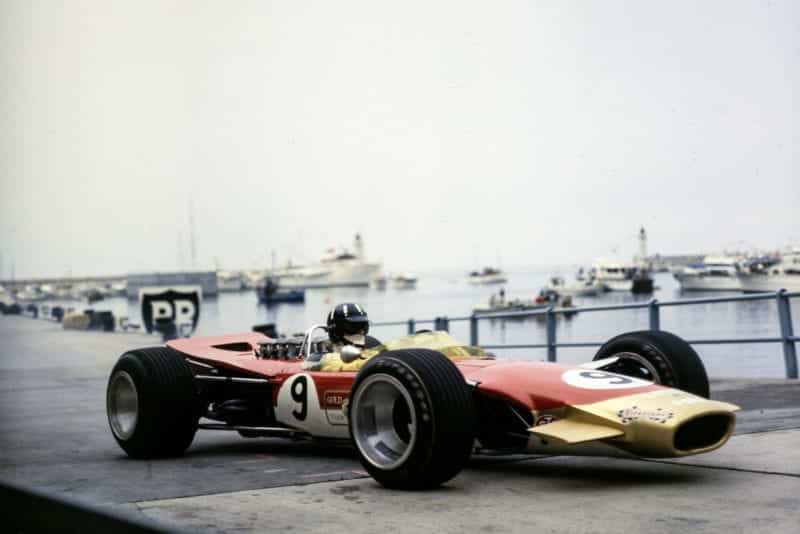
Hill retook the lead when Servoz-Gavin retired
Motorsport Images
Meanwhile the moment of glory for the leading Matra had come to an end for the left-hand drive shaft broke in two, clean through the tubular part, the flailing ends breaking the top suspension link, and he limped into the pits to retire.
“The moment of glory for the leading Matra had come to an end for the left-hand drive shaft broke in two”
Hill now had a clear road ahead and he settled down to lead the race, but Siffert stayed with him and they opened up a small gap between the Cosworth-powered cars and the Honda, which was lying third, with Rindt close behind and Attwood and Rodriguez following. Then came Beltoise in the V12 Matra, Brabham, Gurney and Hulme with the two Coopers bringing up the rear.
For four laps it was a case of follow-my-leader and try and keep up with Hill, who was not setting any records but going fast enough to control the pace, lapping in 1min 31.2sec.
Brabham stopped at the old station hairpin when a rear radius arm came loose from the chassis, the anchor bolt having broken (or just fallen out!), and Gurney went by with his engine spluttering, stopping after nine laps, and again on the next lap, this time for good. Nothing could be found wrong at a quick glance, but it was running so badly that there was no point in going on and risking another major engine breakage, so Gurney drew his starting money and sat and thought about winning Indianapolis, which was much more important.
The lap after Brabham had stopped Rindt went down the hill from the Casino Square thinking he would get past Surtees, but the Honda driver thought differently and as he rounded the Mirabeau hairpin be looked at the cloud of dust in his mirrors which was Rindt severely bending his Brabham on the guard-rails. After only ten laps there were ten cars left running. Hill leading confidently in the Lotus 49, followed by Siffert in the Walker Lotus 49, then Surtees in the Honda, and after a short gap the two BRM V12 cars of Attwood and Rodriguez, all these maintaining a good pace.
Beltoise was some way back in the V12 Matra, running quite well in its first race, and he was followed by Hulme in the orange McLaren, who must have been wishing he could concentrate on Monaco or Indianapolis and not have to do both, for he should have been up with the leaders.
Scarfiotti had caught and passed Bianchi, as the latter’s engine was running on eleven cylinders, but they were both a long way behind. Courage was still running but was not happy for the rear of the BRM seemed to be doing as much steering as the front!
Having just reviewed the situation two more cars dropped out, for Siffert’s crown-wheel and pinion broke up and Beltoise hit a kerb and severely bent the right front suspension rocker-arm and drove slowly to the pits with the nose scraping the ground.
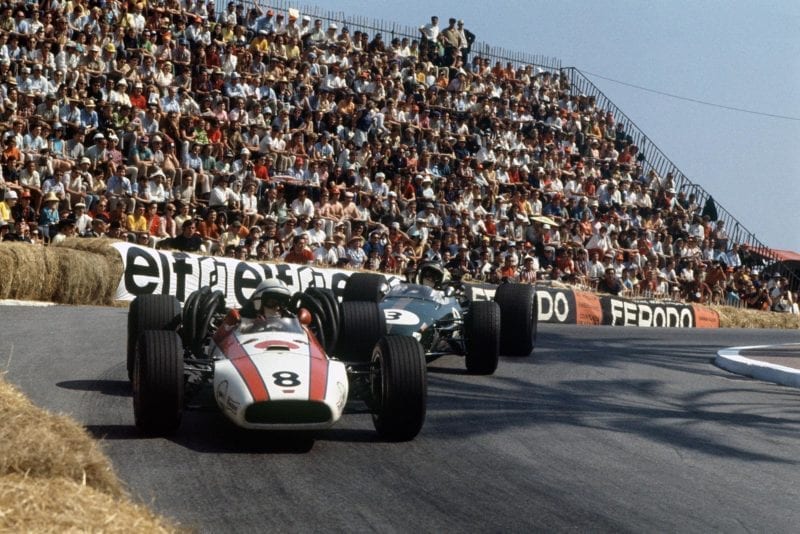
John Surtees, seen here leading Jochen Rindt, retired whilst running 2nd
Motorsport Images
Courage stopped to say that he had had enough of the peculiar handling of his BRM and it was then seen that the fabricated rear cross-member had split, and the flexing had cracked a brake pipe, which explained the earlier loss of brake fluid.
At only 15 laps the field was reduced to seven cars, which made one think about having reserve entries standing by who would be allowed to join the race as one of the original competitors dropped out!
Two laps later this flippant thought changed to a serious one for the Honda was no longer behind the leading Lotus, its gearbox had broken and Surtees toured round to the pits to retire, and almost at the same time Rodriguez had crashed his BRM on the Mirabeau hairpin guard-rails and left the wreckage there. Bianchi had been lapped by Hill, and the order now was Hill, Attwood, Hulme, Scarfiotti, Bianchi and that was all that was left.
The Lotus pit kept their driver accurately informed and Hill settled down to a regular pace, his eyes on the pit board showing how far behind Attwood was, and on his mirrors, and he drove just fast enough to keep in front without putting any undue strain on the car.
The rear suspension was unproven in racing conditions, it was the first Lotus 49 to use a Hewland gearbox, the brakes were of a new pattern as was the front suspension, and to overcome the practice oiling troubles the catch-tank was being used as part of the dry-sump system and a temporary catch-tank was fitted on top of the gearbox; new 15” wide rear tyres were being used on a new construction of magnesium wheel, so that altogether Hill was driving a rather experimental car and he was wise to set his pace to that of the BRM rather than try to out-pace it.
“Attwood was doing a fine job of work, more than justifying his second-chance in Grand Prix racing”
Attwood was doing a fine job of work, more than justifying his “second-chance” in Grand Prix racing and he kept pressing as hard as he could, both cars lapping in under 1min 30sec. Hulme was virtually touring round in a lonely third place, unable to stay with the leaders and in no danger of being caught by the two Coopers, but he did not look happy or satisfied. Hill kept the gap at around four seconds and from lap 20 onwards it was a case of stale-mate and whether anything on the Lotus would give trouble.
At half distance there was no change in the situation, except that Hulme was close to being lapped, and Bianchi had been lapped twice. On lap 45 Scarfiotti hit the exit of the chicane with his right front wheel and smashed the magnesium rim, but was able to limp round to the pits and have a new wheel fitted, but the stop put him back behind his team-mate, whose engine was still sick.
On lap 44 Hulme drew into the McLaren pit with a nasty grinding noise coming from inside the inner universal pot-joint of one of the drive shafts. The McLaren team worked away and fitted another shaft and Hulme rejoined the race while the leaders were on lap 51.
The Lotus and the BRM were circulating consistently though the gap had widened just a little and Hill was obviously master of the situation; Attwood was doing his best, but neither driver put a wheel wrong so there was not likely to be any change in the situation while the cars ran well.
With the present rule that a driver has to complete nine-tenths of the race distance to be classed as a finisher it meant that the remaining runners had to cover more than 72 laps while the winner was doing 80 laps.
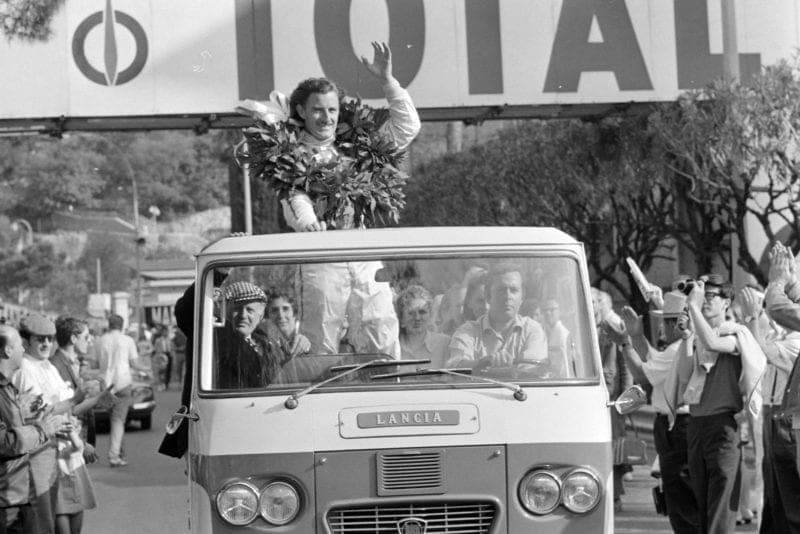
Hill celebrates his victory with a lap of honour
Motorsport Images
Hulme’s pit step had dropped him back seven laps and on the road he was only fifteen seconds ahead of Hill and likely to be caught and passed, which would have made him eight laps behind and just outside qualification distance. His pit urged him on and he had to make a great effort and lap as fast as the leaders, who were now going round in under 1min 29.0sec, with light fuel loads and a clear track.
“Never has anyone had to drive so hard in order to finish last as Hulme”
Never has anyone had to drive so hard in order to finish last as Hulme did in the last fifteen laps of the race, and on the last lap Hill had the McLaren in view, but was still six seconds ahead of Attwood so he eased back and followed the McLaren to the completion of the lap and the chequered flag, with Attwood arriving a mere 2.2sec later.
Hill did not realise Hulme’s difficulty, but he appreciated that he was going fast, and decided not to risk trying to lap him on the last lap of the race, as he had sufficient distance in hand over Attwood. They were both lapping close to record speeds and on the last lap Attwood recorded 1min 28.1sec to establish a new record, though the organisation at first gave this as lap 76, amending it later.
Once again the Coopers had gone slowly but surely and gained third and fourth places, which did not look impressive at the time, but in the final reckoning at the end of the season will look better than Honda, Brabham, McLaren, Eagle and Matra who have scored a row of retirements.
Monaco Murmurs
- Lotus have now won the Grand Prix races in S. Africa, Spain and Monte Carlo in 1968. Matra led all three races, albeit briefly, but their day must surely come.
- Stewart was a spectator, with his wrist in plaster and having to watch “his” car lead the race in the opening laps. All because of a silly mistake in a Formula Two race.
- If drivers were made to-pay for the broken wheels and bent suspensions throughout the meeting they would drive a lot more carefully.
- Looking at the starting grid, seasoned drivers like Gurney, Scarfiotti, Brabham, Hulme and McLaren must have wondered what they had been doing in practice. The brand new Lotus can hardly have been perfect on its first time out, and Servoz-Gavin was in his first Grand Prix race.
